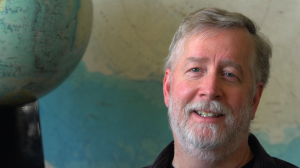The end of the semester approached as we prepared for our first big interview for Beyond the Ice. We would be interviewing physical oceanographer Doug Martinson about the oceans’ role in climate change. For the students, it would be our first shoot for the project, and we were eager for the hands-on experience. We arrived at the Film Bureau at 7:30 A.M., packed our equipment, and departed for Lamont-Doherty Earth Observatory at Columbia University. It was exciting for us to meet real scientists and interview them for the first time as a team. Prepared with a list of questions for Doug Martinson, his answers were seamless and his stories as a young researcher were thrilling.
Doug was completely different than we expected him to be. As he sat calmly by his desk, he reminisced about his life as a young researcher at a winter ice camp in the Weddell Sea in 1992. He shared with us how he and his team stayed warm in minus 36 degrees weather and wearing eleven layers of clothes. He also told us about the way people died in such freezing weather at camps in the old days. It reminded us of the risks these scientists take to pursue the research they believe is important for us all.
When Doug discussed his research, he gave us a detailed overview about the physics of the ocean and the instruments he uses to measure and observe the ocean. Generally, it is the physical system of the environment that controls the ecology of the oceans. Doug measures the physics, temperature, salinity, currents, and the heat of the continent shelf. He told us that the default standard instrument that physical oceanographers use is the CTD which measures the salinity and temperature, while the moorings are essentially instruments attached to a long rope that are anchored to the bottom of the ocean. Doug also discusses the role of the Antarctic Circumpolar current, a large pool of warm water that circulates around the continent. Wherever it touches the continent, it melts the ice and raises the sea level. This is just one of the ways the ocean influences the Antarctic climate.
The science we learned was dense and heavy stuff, but we couldn’t have learned all of it in a better place than the beautiful Palisades. We couldn’t believe we were given such an opportunity, and we just hope that this shoot was one of just many to come in the future.




 Follow the
Follow the  Subscribe to the blog RSS feed
Subscribe to the blog RSS feed